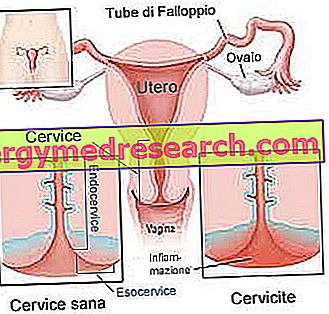What's this
What is the Binge Eating Disorder?
The Binge Eating Disorder (BED), also known as binge eating disorder, seems to be the most common eating disorder (DCA) among males, with a prevalence estimated at 40%, against 10-15% of bulimia nervosa (BN ) and 5-10% of anorexia nervosa (AN).

In literature there are not numerous studies on the male Binge Eating Disorder, as generally the observed samples are female or mixed, therefore, the pathological description reported in this chapter will not make distinctions between the two sexes.
Diagnosis
Diagnostic criteria of Binge Eating Disorder
The diagnostic criteria of the Binge Eating Disorder - updated to DSM IV - are:
- Recurrent binge episodes associated with at least three of the following symptoms:
- Eat much faster than normal
- Eat until you feel unpleasantly full
- Eat large quantities of food even if you are not hungry or hungry
- Eat in solitude for shame
- Feel disgust with yourself, depression, and guilt after each episode
- There is a marked discomfort with bulimic behavior
- Binge eating takes place on average at least 2 days a week for a period of 6 months
- Bulimic episodes are not associated with regular methods of compensation (self-induced vomiting, abuse of laxatives, strenuous exercise) and do not necessarily occur in the course of AN or BN.
factors
Risk factors and predisposing Binge Eating Disorders
In the Binge Eating Disorder there are numerous studies on risk factors and on those triggering binges, but none offers completely exhaustive answers, although the multifactorial theory that includes: is often quoted in the literature.
- Genetic factors
- Neuroendocrine factors
- Evolutionary and affective factors
- Social factors.
Experiences of childhood life and the onset of BED
Among these, the difficult experiences of childhood life, the presence of depressive disorders in the parents, the tendency to obesity and the repeated exposure to negative comments regarding the shape, the weight and the mode of feeding would seem to play a fundamental role.
What triggers binges in the BED?
Contrary to what happens in bulimia nervosa, binges could represent an escape or an emotional block and of thinking in front of an emotional state considered intolerable, or represent a difficulty in the management of impulses; similarly, in the Binge Eating Disorder, other impulse-related behaviors can be triggered such as alcoholism, drug addiction, self-injury, kleptomania and sexual promiscuity.
Food, weight and appearance: how important are they in the BED?
From the psychopathological point of view, the polarization of thought on food, weight and physical appearance does not seem as strong as in other eating disorders.
BED correlations
Extensive studies show that the Binge Eating Disorder possesses specific genetic correlates, a peculiar socio-demographic distribution between the sexes and the different ethnic groups, and a high comorbidity with depression, whose prevalence in the lifetime of these patients is around the 60%. The correlation between Binge Eating Disorder, obesity and attempts at weight reduction is still to be precisely defined; based on a 1997 study, excess weight and the consequent recourse to dietary therapies that regularly occur in Binge Eating Disorders, could be a simple consequence of the pathological manifestation, and not a risk factor as happens for BN.
Distribution and population of the BED
Currently, the Binge Eating Disorder is considered a widespread eating disorder and is thought to affect 2-3% of the general adult population. Its prevalence grows parallel to the degree of overweight; studies carried out on the general population in Italy show that the prevalence of the disorder is estimated between 0.7% and 4.6%, while other jobs carried out in the United States report an incidence of 5% in the obese of the general population, 10- 15% of obese people using commercial programs to lose weight, 30% of obese people seeking treatment for obesity in specialized centers, and - in those who intend to undergo bariatric surgery - the disorder could exceed 50%. It is believed that this disorder affects more between the second and third decades of life, nevertheless, retrospective investigations have revealed that the loss of control over food begins much earlier than the diagnosis and generally before the age of twenty; this time span between onset and diagnosis may partly explain the tendency to chronic disorder.
Genetic and family influences of BED
There are not many studies on genetic influences in Binge Eating Disorder, but some data indicate that the prevalence of the disorder is higher in individuals who have at least one first-degree relative who suffers from the same disease (60%), compared to families in which this is absent (5%). Small-scale research has not shown the familial or significant relationship between Binge Eating Disorder and other eating or psychiatric disorders. In another study in which over 8000 Norwegian twins of both sexes were evaluated, the Binge Eating Disorder appears to be affected almost equally by genetic (41%) and environmental (59%) factors, with a slight prevalence of the latter. In a study of molecular genetics on a sample of 469 obese, of whom 24 with a melanocortin-4 receptor mutation, it was shown that all carriers of this alteration were positive for the diagnosis of Binge Eating Disorder.
Hormonal factors in BED: are they imported?
For years, research has also focused on the possible influence of hormonal factors in the pathogenesis of binge eating, among which the most scrutinized are insulin, adiponectin, leptin and ghrelin, and cannabinoids. The first studies on the family styles of Binge Eating Disorders compare 43 abusers with 88 subjects suffering from other eating disorders using the Family Evironmental Scale; Binge Eating Disorders achieved lower scores regarding family cohesion, expressed emotion, active fun, personal independence; vice versa they report higher levels of conflict and interfamiliar control.
Cultural and psychosocial factors of BED
Furthermore, in the last study mentioned above it was found that compared to other subjects suffering from other eating disorders, Binge Eating Disorders had a lower cultural level.
Among the psychosocial factors capable of influencing the onset of the disease, concern and dissatisfaction with the body image or weight and the frequent use of slimming diets have been highlighted.
These factors explain 61-72% of the variance of symptoms in men and 70% in women.
To learn more: Uncontrolled Eating Disorder Symptoms »Treatment
Binge Eating Disorder Treatment
In the literature there are very few data concerning the treatment of Binge Eating Disorder and the efficacy of the therapies used; it should be noted that, in the short term, the frequency of binges decreases significantly in response to pharmacological therapy with antidepressants and to various forms of psychotherapy such as: CBT, group IPT, behavioral therapy of obesity and self-help with manuals; despite the reduction of binges, no significant weight reductions were observed.
Bibliography
- Adami, GF, Gandolfo, P., Bauer, B., and Scopinaro, N. (1995) Binge eating in massively obese patients undergoing bariatric surgery; International Journal of Eating Disorders; 17: 45–50.
- American Psychiatric Association (1994); Translators: Antonella Armani, Piera Fele, Mauro Mauri, Massimo Rossi, Francesco J. Scarsi; - TR translators: Susanna Banti, Mauro Mauri; Diagnostic and statistical manual of mental disorders; 624-637; 834-835.
- Branson, R., Potoczna, N., Kral, JG, Lentes, K., Hoehe, MR, and FF Horber (2003) Binge Eating as a Major Phenotype of Melanocortin-4 Receptor Gene Mutations; The New England Journal of Medicine; 20 March; 348; 12: 1096-1102.
- Bulik CM, Tozzi F., Anderson C., Mazzeo SE, Aggen S., and Sullivan PF (2003) The relation between eating disorders and components of perfectionism; American Journal of Psychiatry; 160: 366-368.
- Claes L., Nederkoorn C., Vandereyken W., Warriors R., Vertommen H. (2006a) Impulsiveness and lack of inhibitory cotrol in eating disorders. Eating Behaviors; 7: 196-203.
- French, S., et al. (1997) Ethnic differences in psychosocial and health behavior related to dieting, purging, and binge eating in a population-based sample of adolescent females; International Journal of Eating Disorders; 22: 315-322.
- Fowler, SJ, and Bulik, CM (1997) Family Environment and Psychiatric History in Women with Binge-eating Disorder and Obese Controls; Behavior Change; 14: pages 106-112.
- Hodges EL, Cochrane CE, Brewerton TD (1998) Family characteristics of binge-eating disorder patients; International journal of eating disorders; march 1998; 23: 145-151.
- Loriedo C., Bianchi G., Perella C. (2002) Binge Eating Disorder: clinical, nosographic and therapeutic aspects; Italian Journal of Psychopathology; Mar. 8 (1).
- Monteleone P., Matias I., Martiadis V. (2005) Bood levels of the cannabinoid anandamide are uncreated in anorexia nervosa and binge eating disorder, but not in bulimia nervosa; Neuropsychipharmacology; 30: 1216-1221.
- Mussel M., Mitchell J., Weller C. (1995) Onset of Binge Eating, dieting, obesity, and mood disorder among subjects seeking treatment for Binge Eating Disorders. Int J. Eat Disord; 17: 4: 395-401.
- Spitzer, RL, Devlin M., Walsh BT, Hasin D., Wing R., Marcus M., Stunkard A., Wadden T., and Yanovski S. (1992) Binge eating disorder: A multisite field trial of the diagnostic criteria ; International Journal of Eating Disorders; 11: 191-203. Spitzer RL, Yanovski S., Wadden T., Wing R., Marcus MD, Stunkard A., Devlin M., Mitchell J., Hasin D., and Horne RL (1993) Binge eating disorder: Its Further Validation in a Multisite Study; International Journal of Eating Disorders; 13: 137-153.
- Wolf EM and Crowther JH (1983) Personality and eating habit variables as predictors of severity of binge eating and weight. Addictive Behavior; 8: 335-344.
- Womble LG et al. (2001) Psychosocial variables associated with binge eating in obese males and females; International Journal of Eating Disorders; 30: 2: 217.
- Yanovski SZ, Nelson JE, Dubbert BK, and Spitzer RL (1993) Association of binge eating disorder and psychiatric comorbidity in obese subjects; American Journal of Psychiatry; pag 150, pag 1472-1479.



